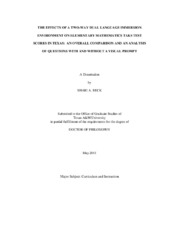| dc.contributor.advisor | Schielack, Jane F. | |
| dc.contributor.advisor | Burlbaw, Lynn M. | |
| dc.creator | Beck, Shari A. | |
| dc.date.accessioned | 2012-07-16T15:56:51Z | |
| dc.date.accessioned | 2012-07-16T20:16:10Z | |
| dc.date.available | 2012-07-16T15:56:51Z | |
| dc.date.available | 2012-07-16T20:16:10Z | |
| dc.date.created | 2011-05 | |
| dc.date.issued | 2012-07-16 | |
| dc.date.submitted | May 2011 | |
| dc.identifier.uri | https://hdl.handle.net/1969.1/ETD-TAMU-2011-05-9246 | |
| dc.description.abstract | With the dynamics of the growing population of native Spanish-speaking students in America’s public schools, two-way dual language immersion programs are
increasing in number. A series of observations and interviews in a dual language program by the researcher led to the identification of the use of visuals as a prevalent component integrated in instruction. This dominant instructional strategy led to questions of how visuals might affect student performance. Previous studies had not focused specifically on questions with a visual prompt and questions without a visual
prompt.
The purpose of this study was to answer several questions focused on differences in student performance on nonvisual and visual questions. The research questions used to achieve this purpose included a comparison of Mathematics TAKS Test scaled scores
for students in a two-way dual language immersion program and students enrolled in a
monolingual educational program, an analysis comparing these two groups of students on nonvisual and various categories of visual questions, an analysis of the performance of both groups of students based on the comparison of nonvisual questions to subsets of visual questions, and an analysis of an interaction effect and main effects of question
type and group based on educational setting.
A quasi-experimental design with static-group comparison was used for the purposes of this study. Data were collected from the Texas Education Agency [TEA] for
all students who took the Spring 2009 version of the Grade 3 or Grade 4 Mathematics TAKS Test in English or Spanish. Data from a total of 6,904 students were used in the study. Data were analyzed based on descriptive statistics and ANOVAs.
A statistically significant difference was found in overall scaled score comparisons between the two groups of students on the Spanish version of the Grade 4
Test. Major findings of the study included a higher performance shown on most subsets of visual questions compared to nonvisual questions for both groups of students involved in this study. Two-way dual language immersion students scored higher than students in a monolingual English program on most subsets of visual questions, but no interaction
effect occurred between question type and group. | en |
| dc.format.mimetype | application/pdf | |
| dc.language.iso | en_US | |
| dc.subject | Bilingual education | en |
| dc.subject | Mathematics education | en |
| dc.subject | visuals | en |
| dc.title | The Effects of a Two-Way Dual Language Immersion Environment on Elementary Mathematics TAKS Test Scores in Texas: An Overall Comparison and an Analysis of Questions With and Without a Visual Prompt | en |
| dc.type | Thesis | en |
| thesis.degree.department | Teaching, Learning, and Culture | en |
| thesis.degree.discipline | Curriculum and Instruction | en |
| thesis.degree.grantor | Texas A&M University | en |
| thesis.degree.name | Doctor of Philosophy | en |
| thesis.degree.level | Doctoral | en |
| dc.contributor.committeeMember | Schielack, Jr., Vincent P. | |
| dc.contributor.committeeMember | Cifuentes, Lauren D. | |
| dc.type.genre | thesis | en |
| dc.type.material | text | en |


